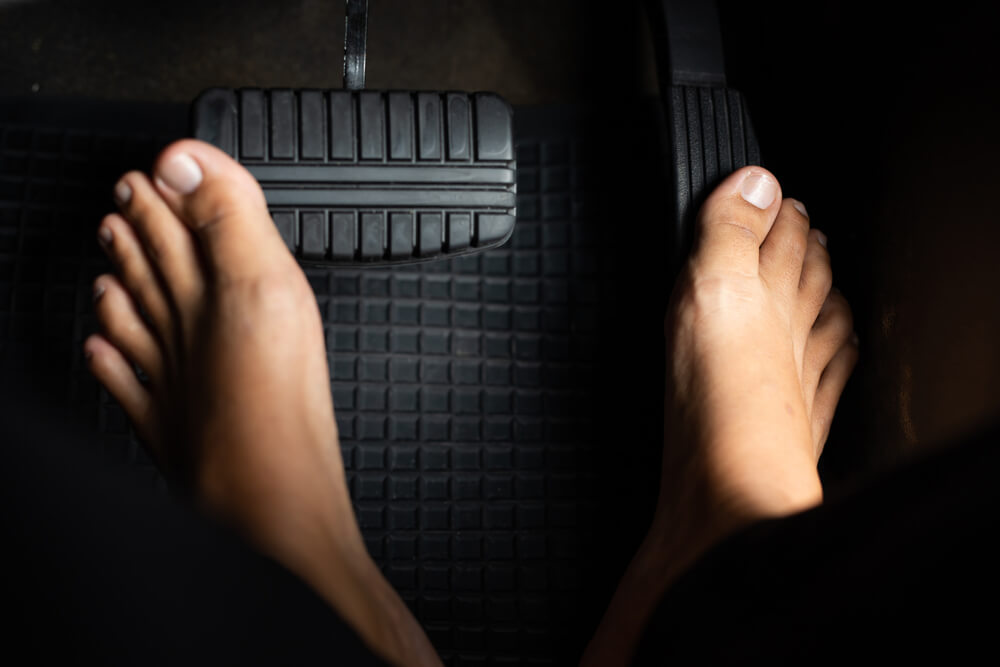Every seasoned driver has wondered whether habits picked up over the years are really legal or just tradition. Driving barefoot is a practice that divides opinions—some swear by the freedom and feel of the pedals, while others worry about safety and potential legal consequences. In California, where car culture is as strong as anywhere in the world, understanding the true facts about barefoot driving is essential. This article uncovers the latest information, addresses common misconceptions, and provides practical guidance for drivers of every experience level.
What the Law Actually Says
Despite persistent rumors and heated debates, California law is clear on barefoot driving. Nowhere in the California Vehicle Code does it specifically prohibit driving barefoot. In fact, there is no explicit rule in the entire codebase requiring motorists to wear shoes or specific types of footwear while behind the wheel.
Key points to understand include:
-
The California Vehicle Code does not mention shoes or mandate footwear while driving.
-
Law enforcement agencies do not issue tickets purely for driving barefoot.
-
If driving barefoot results in unsafe driving or contributes to an accident, a driver might be cited for careless or reckless driving, but not for being barefoot itself.
Therefore, Californian drivers are not breaking the law by operating vehicles barefoot. However, if their choice of footwear—or lack thereof—causes them to lose control of their vehicle, legal consequences may arise under other statutes.
Barefoot Driving in California: Legal Details
California’s legal landscape is shaped by clarity in statutory language. The California Department of Motor Vehicles (DMV) provides guidance on safe driving practices but does not regulate specific dress codes or footwear. The primary concern for law enforcement is whether a driver is operating their vehicle safely and in control at all times.
Law enforcement officials confirm that:
-
Drivers may be ticketed if their method of driving demonstrates impairment, distraction, or inability to control the vehicle, regardless of footwear.
-
After an accident, insurance investigators and police might consider barefoot driving as a contributing factor, especially if pedal misapplication is involved.
-
The main criteria used in enforcement are control, safety, and the ability to react quickly and effectively while driving.
This means that while driving barefoot is not itself illegal, it can become a factor in determining fault or recklessness following an incident.
Why the Myth Exists
The belief that driving barefoot is illegal is among the most widely held traffic misconceptions—not just in California, but across the United States. The origins of this myth likely stem from a mixture of safety warnings, urban legends, and well-meaning advice passed down through generations.
Reasons the myth persists include:
-
Anecdotal stories of drivers being warned or ticketed (often due to unrelated violations).
-
Driving instructors frequently admonish new drivers to wear “proper footwear,” sparking rumors that it’s a legal requirement.
-
Movies, TV, and popular culture sometimes depict barefoot drivers involved in mishaps, reinforcing the myth.
The combination of these factors continues to fuel the false narrative, even in the absence of any written law.
Safety Perspectives: Experts Weigh In
While the law does not ban barefoot driving, safety experts have mixed opinions. The National Highway Traffic Safety Administration (NHTSA) has stated that improper footwear—including sandals or high heels—can interfere with safe driving. However, there is no consensus that barefoot driving is inherently less safe than other forms of driving.
Key safety considerations include:
-
Bare feet can sometimes provide better pedal feel and control than thick-soled or cumbersome shoes, especially in emergencies.
-
Drivers who are not used to driving barefoot may misjudge pedal pressure or slip on wet or sweaty pedals.
-
Experts generally caution against flip-flops, high heels, and platform shoes, which pose higher risks of snagging on pedals or slipping.
The bottom line from most safety organizations is that drivers should wear whatever gives them the best control over the pedals—and for some, that might mean no shoes at all.
Benefits and Risks of Driving Barefoot
Choosing whether to drive barefoot is more than a legal issue—it’s also about comfort, safety, and personal preference.
Potential Benefits:
-
Better tactile feedback, allowing for more precise gas and brake control.
-
Elimination of shoe-related risks, such as soles catching on pedals or slipping off.
-
Cooler and more comfortable on hot days, especially in beach towns or after sports.
Potential Risks:
-
Increased risk of pedal slippage if the foot is wet or sweaty.
-
Skin is more vulnerable to heat or debris on floorboards.
-
Higher risk of injury in the event of a crash, such as broken glass or twisted pedals.
Ultimately, the best choice depends on individual comfort and experience behind the wheel.
Common Scenarios and Road Conditions
Barefoot driving can mean different things depending on where and how it’s done. Below are a few typical scenarios and considerations for California drivers:
-
Beach trips: After walking at the beach, many drivers hop in barefoot. As long as sand doesn’t cause pedal traction issues, this is legal and common.
-
Hot weather: In the Central Valley or desert regions, barefoot driving might be more comfortable, especially after sandals become too hot.
-
Emergency situations: People sometimes drive barefoot if shoes are lost, damaged, or uncomfortable.
-
Long drives: For lengthy road trips, some prefer to switch off shoes for stretches.
While none of these scenarios are illegal, drivers are encouraged to check pedal conditions for sand, moisture, or grime that might affect safety.
Table: State Laws on Barefoot Driving Across the US
To provide national perspective, see below for how different states approach barefoot driving:
| State | Legal Status | Notes |
|---|---|---|
| California | Allowed | No specific restriction |
| Texas | Allowed | Not prohibited, but safety is stressed |
| Florida | Allowed | DMV discourages, but not illegal |
| New York | Allowed | No law against barefoot driving |
| Nevada | Allowed | No explicit code language |
| Alabama | Allowed | No statute on record |
| Ohio | Allowed | Urban legends persist, not illegal |
| Montana | Allowed | Not regulated |
| Georgia | Allowed | Caution recommended, but legal |
| Illinois | Allowed | No prohibition in state law |
Laws are uniform nationwide for the most part, with almost every state allowing barefoot driving.
Driving Barefoot and Insurance Issues
While driving barefoot is not illegal, insurance companies may review it differently in the event of a claim. If lack of footwear is deemed to be a factor in causing an accident—such as slipping off a pedal—an adjuster might consider this negligent behavior.
Insurance adjusters typically examine:
-
Whether loss of control was likely due to driving barefoot.
-
Any previous advisories (such as warnings after incidents).
-
Whether the driver demonstrated a reasonable approach to safety.
However, claims are rarely denied solely because a driver was barefoot; there must be clear, direct causation.
Fact-Check: Barefoot Driving Myths
Let’s break down some of the most common myths associated with barefoot driving in California:
-
Myth: Police will ticket for driving barefoot.
Police do not issue tickets strictly for driving barefoot. -
Myth: Insurance is invalid if driving barefoot.
Insurance may investigate if bare feet caused loss of control, but policies are not voided simply for lack of shoes. -
Myth: Only certain footwear is allowed.
The law is silent on footwear, although individual driving schools may require shoes during instruction. -
Myth: Barefoot driving is only allowed if medically necessary.
No law requires a medical reason for bare feet behind the wheel.
Dispel these misconceptions by understanding what the law and policy documents actually state.
What Footwear Is Best for Driving?
Many drivers wonder if there’s an ideal shoe for safe driving. Footwear that is too slippery, chunky, or rigid can hinder pedal feel. Experts recommend:
-
Lightweight sneakers or driving moccasins for best pedal control.
-
Avoiding high heels, flip-flops, or sandals with loose straps.
-
Considering slip-resistant soles.
Ultimately, the safest choice is whatever allows for stable, confident interaction with the vehicle’s pedals. For some, that may still be bare feet, particularly for short distances or in controlled environments.
Kids, Teens, and New Drivers: Rules Explained
For first-time drivers or teenage learners, driving barefoot is neither required nor banned. However:
-
Many driving instructors require shoes for student drivers in behind-the-wheel courses.
-
Some parents and guardians may set their own house rules about driving attire during training.
-
For minors, safety is generally improved with snug, closed-toe shoes, but there is no legal necessity for this.
Once fully licensed, teenagers have the same rights as adult drivers in terms of footwear choice.
Celebrity and Viral Cases
There have been several viral moments and celebrity anecdotes involving barefoot driving. Social media has recorded everything from casual barefoot stints on joyrides to campaign videos shot with no shoes in sight. While these stories attract attention, none have resulted in tickets for footwear alone. What sometimes makes news is when poor driving follows—especially if the public suspects a lack of shoes contributed.
Despite all the viral buzz, no court cases or police reports in California have confirmed a violation based solely on driving barefoot.
Tips for Safe Foot Management Behind the Wheel
If choosing to drive barefoot, Californians should take practical steps to enhance safety:
-
Clean feet before driving, especially after the beach or pool, to avoid slipping on pedals.
-
Check pedals for sand, water, or loose debris.
-
Adjust seats for optimal leg position, since foot angle can change without shoes.
-
Always keep a pair of shoes in the car for unexpected stops or emergencies.
Small adjustments can make a big difference in confidence and control.
Special Cases and Exceptions
There are unique situations where footwear—or the absence thereof—comes into play, including:
-
Trucking and commercial driving: Some companies have internal policies about footwear for delivery or freight drivers, but state law applies only to public roadways.
-
Motorcycle and moped operation: California law requires motorcycle riders to wear shoes for foot protection, but this does not extend to car drivers.
-
Medical conditions: Drivers with certain conditions may require adaptive footwear or medical exemptions, but standard regulations still do not ban bare feet.
Private fleets or jobs may enact more specific dress codes, even if state law does not.
Table: Top Causes of Pedal-Related Accidents
The actual statistics on pedal-related auto accidents can help clarify the risks involved with different footwear choices:
| Pedal Mishap Cause | Percentage of Incidents |
|---|---|
| Flip-flops or sandals | 34% |
| High heels/stilettos | 20% |
| Bare feet (slippery) | 12% |
| Unfamiliar shoes | 15% |
| Boots/work footwear | 10% |
| Other (wet, muddy, etc.) | 9% |
While barefoot risks are real, ill-fitting or loose footwear statistically accounts for an even greater share of pedal-related incidents.
What If an Accident Happens Barefoot?
If a crash occurs while driving barefoot, the investigation will focus on whether footwear contributed to the event. Important factors include:
-
Witness statements and the driver’s own report regarding pedal control.
-
Physical evidence such as foot marks or signs of slipping.
-
Past driving record and any history of similar incidents.
Barefoot driving may be noted, but unless clearly the cause, it is rare for this alone to lead to fault or citations. However, after an accident, drivers may face increased scrutiny and could be advised to wear shoes in the future.
Driving Professions: Are Rules Different?
Professional drivers—such as cabbies, limo drivers, or delivery workers—are not under any California law requiring shoes while driving. However, company guidelines or insurance policies may set stricter rules for professionals.
Examples include:
-
Delivery companies often require slip-resistant shoes for liability reasons.
-
Rideshare services may recommend but do not typically mandate closed-toed shoes.
-
Bus and truck drivers must abide by commercial regulations, which may require some form of protective footwear.
Despite this, the core legal stance of California remains unchanged: there is no statewide law banning barefoot driving for any profession.
Public Opinion and Driver Surveys
Surveys indicate that public attitudes toward barefoot driving are split. Key findings from recent polls:
-
About one-third of California drivers have driven barefoot at least once.
-
Around 60% believe it is unsafe, but less than 10% think it is illegal.
-
Women are more likely than men to kick off shoes on long drives or after work.
-
Younger drivers are more likely to try barefoot driving, but less likely to do so regularly.
Public opinion leans toward caution, but very little support exists for banning the practice outright.
Final Thoughts
The notion that driving barefoot is illegal in California is pure myth. California drivers are free to wear—or not wear—whatever footwear feels best, so long as it does not interfere with safe operation of the vehicle. The law is concerned with safety and control, not dress codes. While some shoes present risks greater than bare feet, the ultimate responsibility rests with each individual driver to exercise good judgment.
For anyone considering a shoeless drive along the Pacific Coast Highway or a quick barefoot run to the grocery store, the answer is clear: it’s legal, provided the driver remains in full control at all times. As always, prioritize safety, comfort, and awareness—whatever is or isn’t on your feet.











Leave a Comment